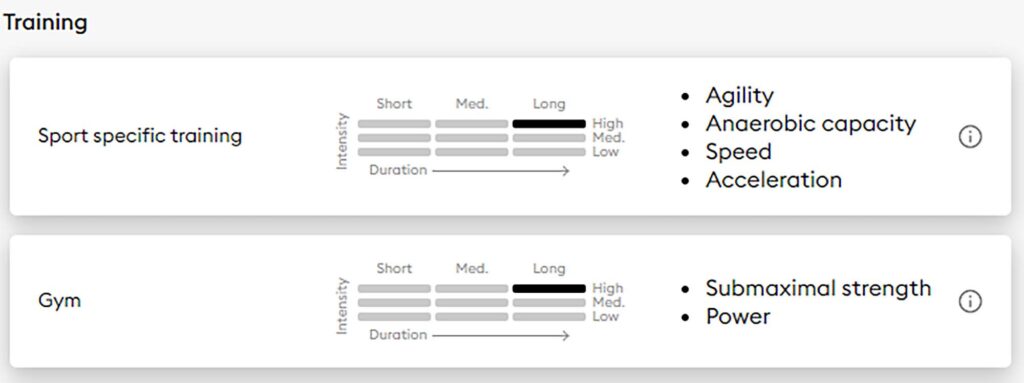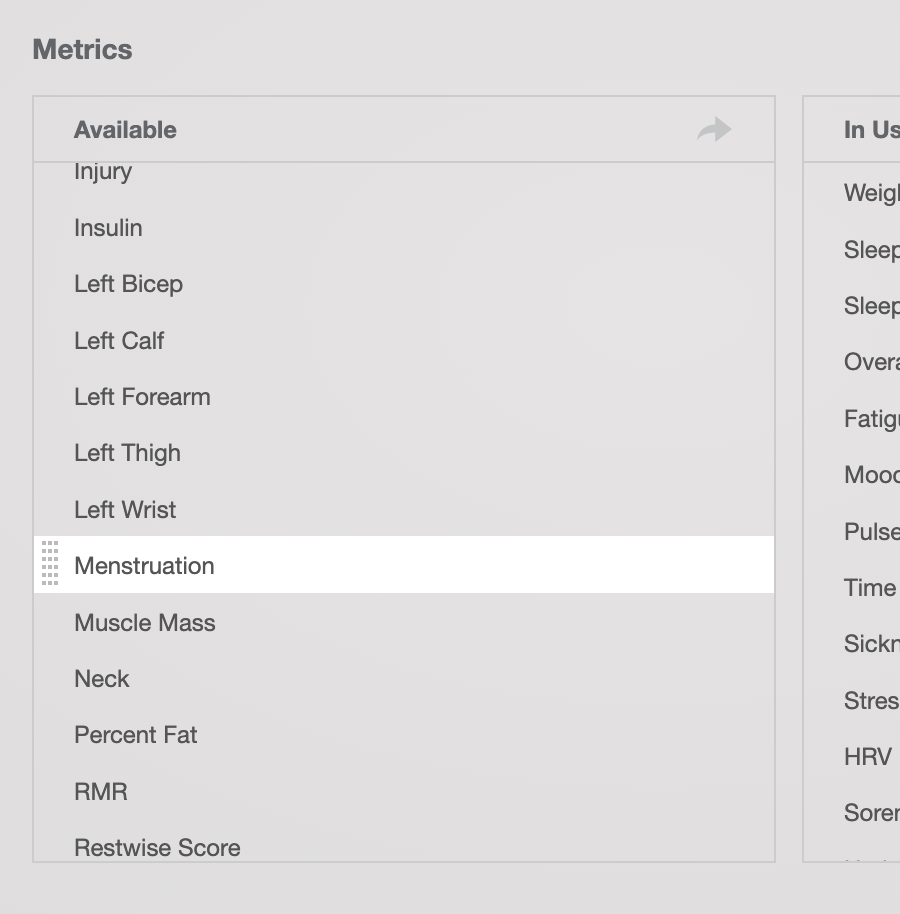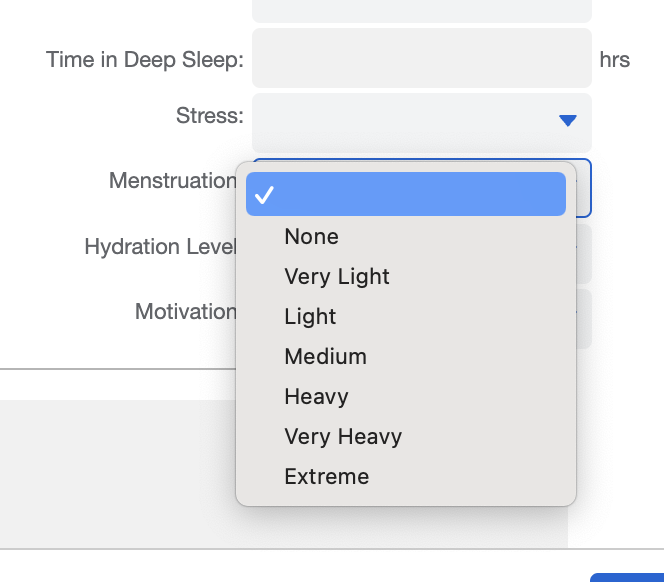When I talk about women-specific training, I often see puzzled looks on people’s faces. Many people shy away from these conversations. Talking about female physiology and how it affects our training may be the missing piece to a possible breakthrough performance for some female athletes. I was one of them.
As often happens, facing adversity and going through some rough times in my personal life caused something unexpected and exciting. Trying to survive and noticing my mental and physical health declining, I started checking in with my body more often, listening to what it was telling me. That’s when I started tracking my menstrual cycle and noticing the definite patterns that would repeat every month like a clock. My energy levels, my concentration, my ability to nail hard workouts, my motivation, my food cravings and even my low back pain — I could predict when it would happen in the next cycle.
This initial curiosity prompted me to do a lot more research and education on the topic of female physiology, and finally, I became an experiment of one — applying my knowledge to my unique female body. Little did I know when I started this journey that it would eventually lead me to have the best year in my athletic career, placing first in my Age Group in Ironman and Ironman 70.3 events, something I was never able to come even close to with my previous training.
The topic of the menstrual cycle and hormonal fluctuations never came up with any of my coaches, but it’s time to change this for other female athletes. Here is what you need to know about the menstrual cycle, cycle tracking tools, and how to tailor training for each cycle phase.
Menstrual Cycle as a Health Indicator
The American College of Obstetricians and Gynecologists (ACOG) defines the menstrual cycle as a complex process orchestrated by interactions between many of the body’s tissues, cells and hormones. It reflects a woman’s overall health status and can be thought of as a “fifth vital sign,” along with blood pressure, body temperature, heart rate and respiratory rate.
Pause for a second and think about that — it reflects a woman’s overall health. Should we not, as coaches, be concerned about our clients’ overall health? We ask questions about blood pressure, diabetes, previous surgeries, etc., but rarely does the topic of the menstrual cycle come up in a conversation or as a question on an athlete’s intake form.
For a woman who may already be in sync with her body and know her hormonal state throughout the cycle, sharing that information with a coach may be all that is needed to take it to the next level. The coach then can make appropriate programming that reflects each cycle phase, allowing the athlete to feel and perform their best.
Women who may not know what’s happening throughout their cycle can benefit from some guidance. It’s a personal topic, and some female athletes may not be comfortable sharing this information. However, if they understand how this information is being used and its benefits to their training, they will often want to use the power of female hormones to their training advantage.
Tip: Check out this article for ways that athletes and coaches can normalize talking about the menstrual cycle: How to Normalize Talking About Menstrual Health With Your Athletes.
Cycle Tracking Tools
I believe cycle tracking is the greatest act of self-care a woman can have. It’s a free monthly wellness check that most females have until they reach perimenopause. With very little time investment, most women can get massive rewards in their training and overall well-being with simple cycle tracking.
There are multiple ways to track a cycle: as simple as pen and paper and as complex as monthly subscription services. Dozens of apps allow women to track their cycle and symptoms: Wild AI, Fitr Woman, Clue and Natural Cycles, just to name a few. Garmin and TrainingPeaks allow cycle tracking through their interfaces as well.

I am a big fan of Wild AI because it has a coach account that allows a coach to see their athletes’ menstrual cycle phase. It also gives training recommendations for that given phase based on each person’s check-ins. Coaches do not see details, only the overall readiness score.
With a glance at the WildAI app dashboard, coaches can see where a particular female athlete’s strengths and weaknesses are based on their physiology.

What This Means for Coaches
Equipped with this kind of information, coaches can adjust workouts accordingly. Early on in this process, frequent check-ins with an athlete are essential for the program’s success. After a few cycles, the process becomes easier and more predictable for both the athlete and the coach.
After doing this for myself and my athletes for quite some time, I often ask myself — what might the best training approach for a given athlete at a given time in her cycle look like? It’s a time investment at the beginning, but it pays huge dividends overall. Also, it demonstrates how invested a coach is in their athlete’s success while creating a more trusting relationship between the two.
It can feel difficult for some coaches, especially male coaches, to have this kind of conversation with their female athletes. With so much training programming nowadays being online, the use of the TrainingPeaks calendar as a communication tool could be super useful. I use comments heavily, and it works great for both parties. Once an athlete indicates she started her menstrual cycle, I can chart the phases, and once I have those phases laid out on the calendar, I can plug in specific workouts to match the training load and intensity for that individual athlete.
Tailoring Training For Each Menstrual Cycle Phase
So, what does a regular cycle look like, and what are the common patterns that coaches should know? A few models exist today, the simplest one containing two phases: follicular and luteal. The more complex models contain as many as seven phases. I personally prefer the five-phase model.
The length of the menstrual cycle is the number of days between the first day of menstrual bleeding of one cycle to the onset of menses of the following cycle. The average duration is 28 days, with most cycles falling in the 25-30 range.
Early Follicular Phase
The early follicular phase begins at the start of a period when the uterine wall begins to shed its lining. This phase lasts two to eight days, with the average duration being four to six days. This phase is characterized by the increase in the secretion of a hormone called follicle stimulation hormone (FSH) that is responsible for the formation of follicles containing maturing eggs in ovaries.
This phase is very individual, with some women experiencing menstrual cramps due to uterus contractions trying to expel its lining while others do not experience severe cramping and can continue their training as normal. The sex hormone levels are low during this phase, therefore having minimal impact on carbohydrate availability and other physiological functions.
Studies suggest that high-intensity training could be beneficial at this time and can promote lean muscle mass gain and strength development if a woman is not affected by menstrual symptoms such as severe cramping.
Mid-Follicular Phase
The mid-follicular phase begins when the menstrual bleeding stops. At this point, the body starts preparing an egg and the uterus for possible implantation of a fertilized egg. This is when the estrogen levels start rising, and they continue to rise all the way until ovulation when the egg is released. This phase’s duration varies in length between women and even from cycle to cycle for the same woman.
This phase can last anywhere between 10 to 20 days. Estrogen increase contributes to increased muscle strength and quicker recovery rates, so high-intensity and strength training should be a priority during this phase. However, there is also research indicating that this phase carries a higher injury risk due to estrogen’s effect on connective tissue laxity (ACL injuries in female athletes occur two to eight times more often than in male athletes) so emphasis on a proper and longer warmup may be needed.
Ovulatory Phase
The ovulatory phase begins when an ovary releases the dominant follicle into the fallopian tube, where it has the potential to be fertilized. The egg can survive for 12-24 hours past ovulation. Some women can feel when an egg is released. Tracking cycles is also a good indicator of when ovulation occurs, as most women will start a new cycle 14 days later. Finally, taking the basal temperature in the morning before getting out of bed is another way to detect ovulation, as the basal temperature will be 1/2 to 1 degree higher in the second half of the cycle.
Similarly to the mid-follicular phase, high levels of estrogen continue to contribute to increased muscle strength as well as faster recovery times from exercise-induced fatigue. This is my favorite time to assign benchmark testing to my female clients. HIIT and VO2Max sessions seem easy, and motivation is usually high around this time. If a race happens to coincide with this phase, it would be a great time to chase that PR!
Mid-Luteal Phase
The mid-luteal phase begins after ovulation, when the corpus luteum (the sac that contained the egg) starts secreting estrogen and progesterone, preparing the uterine wall for possible implantation. The mid-luteal phase is believed to be around 10 days, with slight variations between women, but it is not nearly as variable as the follicular phase. After ovulation, core body temperature, energy expenditure and resting heart rate increase while blood plasma volume is reduced, all affecting women’s ability to train.
Progesterone dominates during this phase, and it is a catabolic hormone that can impact the recovery rate and reduce performance at higher intensities. Therefore, lower intensity but longer duration aerobic-type workouts are recommended during this phase.
Late Luteal Phase
The late luteal phase begins when the estrogen and progesterone levels start dropping, preparing a woman’s body for the next cycle. This drop can often cause physical and mental symptoms such as anxiety, mood swings, decrease in performance and energy levels. This phase lasts for about four to six days.
It’s also the time when women need to focus on themselves, practice self-care and be kind and patient with themselves. This is the week that I like to use as a recovery week in the training cycle and include an extra rest day or focus on low-intensity training such as swim drills or pedaling drills on a bike trainer, especially if a woman is experiencing menstrual symptoms.
Again, TrainingPeaks has a way of recording these details and is a great tool that both athletes and coaches should utilize in their communication.


These are the phases that most healthy women who have not reached menopause go through on a monthly basis. Tracking the menstrual cycle and knowing what to expect at each phase is an immensely powerful tool that women can use in their training and everyday life.
Coaches have an opportunity to train their female athletes using the power of hormones by working with female physiology and not against it. It is important to note that various contraception methods may impact the menstrual cycle and the ability to train to the cycle’s strengths. The topic of contraception is covered more in-depth in this TrainingPeaks article.
Menstrual Cycle Disorders
As mentioned earlier, having a regular menstrual cycle is an indicator of a healthy hormonal balance in a biological female body. The absence of the menstrual cycle or an irregular cycle may indicate a serious condition that should be investigated immediately. It’s scary that sometimes women, coaches and even doctors ignore or do not pay enough attention to this problem, and women pay serious consequences at the expense of their health later in life. LEA and RED-S are especially relevant in the younger female athlete population. Girls and women should be educated and regularly checked for symptoms.
Individualized Training Approach for Women
Women’s bodies are amazing and complex, and no two bodies are the same. The complexity of female physiology is partially to blame for the lack of research and studies done on female athletes, and I am very happy to see that it’s starting to change. More research papers are being published to counter the longstanding research biases.
I believe that if women listen to what their bodies are telling them, coaches are educated on the topic of female physiology and apply that training, they may just find the missing piece of the puzzle to a happier, healthier life and consistent athletic achievement!
References:
- Chidi-Ogbolu N, Baar K. (2019, Jan.) Effect of Estrogen on Musculoskeletal Performance and Injury Risk. Front Physiol. 2019 Jan. 15;9:1834. doi: 10.3389/fphys.2018.01834. PMID: 30697162; PMCID: PMC6341375 https://pubmed.ncbi.nlm.nih.gov/30697162/
- F. Miro, L.J. Aspinall (2005, Jan.) The onset of the initial rise in follicle-stimulating hormone during the human menstrual cycle, Human Reproduction, Volume 20, Issue 1 https://doi.org/10.1093/humrep/deh551
- Reed BG, Carr BR (Updated 2018, Aug.) The Normal Menstrual Cycle and the Control of Ovulation. In: Feingold KR, Anawalt B, Boyce A, et al., editors. Endotext [Internet]. South Dartmouth (MA): MDText.com, Inc.; 2000-. https://www.ncbi.nlm.nih.gov/books/NBK279054/
- Stacy T Sims, Alison K. Heather (2018, July) Myths and Methodologies: Reducing scientific design ambiguity in studies comparing sexes and/or menstrual cycle phases https://doi.org/10.1113/EP086797
- Sung E, Han A, Hinrichs T, Vorgerd M, Manchado C, Platen P. (2014, Nov.) Effects of follicular versus luteal phase-based strength training in young women. Springerplus. 11;3:668. doi: 10.1186/2193-1801-3-668. PMID: 25485203; PMCID: PMC4236309 https://www.ncbi.nlm.nih.gov/pmc/articles/PMC4236309/
- Zhang S, Osumi H, Uchizawa A, Hamada H, Park I, Suzuki Y, Tanaka Y, Ishihara A, Yajima K, Seol J, Satoh M, Omi N, Tokuyama K. (2020, Jan.) Changes in sleeping energy metabolism and thermoregulation during menstrual cycle. Physiol Rep.e14353. doi: 10.14814/phy2.14353. PMID: 31981319; PMCID: PMC6981303 https://www.ncbi.nlm.nih.gov/pmc/articles/PMC6981303/








